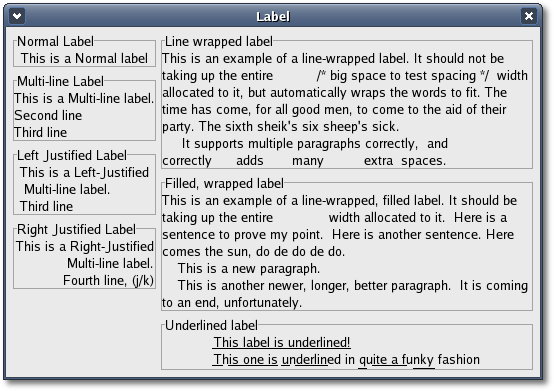Labels
Labels are used a lot in XFC, and are relatively simple. A label displays a small amount of text. As the name implies, most labels are used to label another widget such as a Button or a MenuItem. Labels are 'no window' widgets so they do not receive widget signals. If you need to catch signals, or do clipping, place it inside a Gtk::EventBox widget.
To create a new label, use one of the following constructors:
Label();
Label(const
String& str, bool use_underline = false); The first constructor creates an
empty
label. The
second constructor creates a label that displays the specified
character
string. If 'use_underline' is true the string is
parsed
for an underscore preceding the mnemonic character.
After construction you can change the label's text by calling one of the following methods:
void
set_text(const String& str);
void set_text_with_mnemonic(const String& str);The sole argument to both is the
new string
to display.
The second method, set_text_with_mnemonic(), parses the string for the
mnemonic character (i.e. the character that is preceded by an
underscore). The
space needed for the new string will be automatically adjusted if
needed. You can produce multi-line labels by putting line breaks in the
label string.
To retrieve the current string use:
String
get_text() const;The label text can be justified using:
void
set_justify(Gtk::Justification jtype);The 'jtype' argument can be one of the values from the Gtk::Justification enum:
- JUSTIFY_LEFT
- JUSTIFY_RIGHT
- JUSTIFY_CENTER (the default)
- JUSTIFY_FILL
void
set_line_wrap(bool wrap);The 'wrap' argument takes a true or false value.
If you want your label underlined, then you can set a pattern on the label:
void
set_pattern(const String& pattern);The 'pattern' argument indicates
how the
underlining
should look. It consists of a string of underscore and space
characters.
An underscore indicates that the corresponding character in the label
should be underlined. For example, the string "__ __" would underline
the first two characters and eight and ninth characters. If
you simply want to have an underlined accelerator
(mnemonic) in your label, you should use set_text_with_mnemonic(),
not
set_pattern().
Label Example
This short example illustrates the use of labels. It makes use of the Frame widget to demonstrate each label's style. In XFC, label texts can contain markup for font and other text attribute changes, and labels may be selectable (for copy-and-paste). These advanced features won't be explained here but are covered in the Gtk::Label API reference.The header file for Label is <label.hh>
#include
<xfc/main.hh>
#include
<xfc/gtk/window.hh>
using namespace
Xfc;
class
LabelWindow : public
Gtk::Window
{
public:
LabelWindow();
~LabelWindow();
};and the source file is <label.cc>:
#include
"label.hh"
#include <xfc/gtk/box.hh>
#include
<xfc/gtk/frame.hh>
#include
<xfc/gtk/label.hh>
LabelWindow::LabelWindow()
{
set_title("Label");
Gtk::VBox *vbox = new
Gtk::VBox(false, 5);
Gtk::HBox *hbox = new
Gtk::HBox(false, 5);
add(*hbox);
hbox->pack_start(*vbox, false,false);
set_border_width(5);
Gtk::Frame *frame = new
Gtk::Frame("Normal Label");
Gtk::Label *label = new
Gtk::Label("This is a Normal label");
frame->add(*label);
vbox->pack_start(*frame, false,false);
frame = new
Gtk::Frame("Multi-line Label");
label = new
Gtk::Label("This is a Multi-line label.\nSecond line\nThird line");
frame->add(*label);
vbox->pack_start(*frame, false,false);
frame = new
Gtk::Frame("Left Justified Label");
label = new
Gtk::Label("This is a Left-Justified\n Multi-line label.\nThird line");
label->set_justify(Gtk::JUSTIFY_LEFT);
frame->add(*label);
vbox->pack_start(*frame, false,false);
frame = new
Gtk::Frame("Right Justified Label");
label = new
Gtk::Label("This is a Right-Justified\nMulti-line label.\nFourth line,
(j/k)");
label->set_justify(Gtk::JUSTIFY_RIGHT);
frame->add(*label);
vbox->pack_start(*frame, false,false);
vbox = new Gtk::VBox(false, 5);
hbox->pack_start(*vbox, false,false);
frame = new
Gtk::Frame("Line wrapped label");
label = new
Gtk::Label("This is an example of a line-wrapped label. It should not
be
taking up the "\
"entire /*
big space to test spacing */ width allocated to it, "\
"but automatically wraps the words to fit. The time has come, for all
good men, "\
"to come to the aid of their party. The sixth sheik's six sheep's
sick.\n"\
" It supports multiple paragraphs
correctly, and
correctly
adds "\
"
many extra
spaces. ");
label->set_line_wrap(true);
frame->add(*label);
vbox->pack_start(*frame, false,false);
frame = new
Gtk::Frame("Filled, wrapped label");
label = new
Gtk::Label("This is an example of a line-wrapped, filled label. " \
"It should be taking "\
"up the
entire
width allocated to it. " \
"Here is a sentence to prove "\
"my point. Here is another sentence. "\
"Here comes the sun, do de do de do.\n"\
" This is a new paragraph.\n"\
" This is another newer, longer, better " \
"paragraph. It is coming to an end, "\
"unfortunately.");
label->set_justify(Gtk::JUSTIFY_FILL);
label->set_line_wrap(true);
frame->add(*label);
vbox->pack_start(*frame, false,false);
frame = new
Gtk::Frame("Underlined label");
label = new
Gtk::Label("This label is underlined!\n"
"This one is underlined in quite a funky fashion");
label->set_justify(Gtk::JUSTIFY_LEFT);
label->set_pattern("_________________________ _
_________ _ ______ __ _______ ___");
frame->add(*label);
vbox->pack_start(*frame, false,false);
show_all();
}
LabelWindow::~LabelWindow()
{
}
int main (int
argc, char *argv[])
{
using namespace Main;
init(&argc, &argv);
LabelWindow window;
window.signal_destroy().connect(sigc::ptr_fun(&Xfc::Main::quit));
run();
return 0;
}Compiling Label
If you compiled and installed XFC yourself, you will find the source
code for Label in the
<examples/label> source directory along with a Makefile. If
XFC came pre-installed, or you installed it from an RPM package, you
will
find the source code in the
</usr/share/doc/xfcui-X.X/examples/label> subdirectory. In
this case you will have to create the Makefile yourself (replace X.X
with the
version number of the libXFCui library you have installed).To create a Makefile for Label, add the following lines to a new text file and save it using the name "Makefile":
CC = g++
CFLAGS = -Wall -O2
label: label.cc label.hh
$(CC) label.cc -o label $(CFLAGS) `pkg-config
xfcui-X.X --cflags --libs`
clean:
rm -f *.o labelIf you cut and paste these lines make sure the whitespace before $(CC) and rm is a tab character. When you compile and run this program you will see the following window appear:

| Copyright © 2004-2005 The XFC Development Team | Top |
XFC
4.4 |